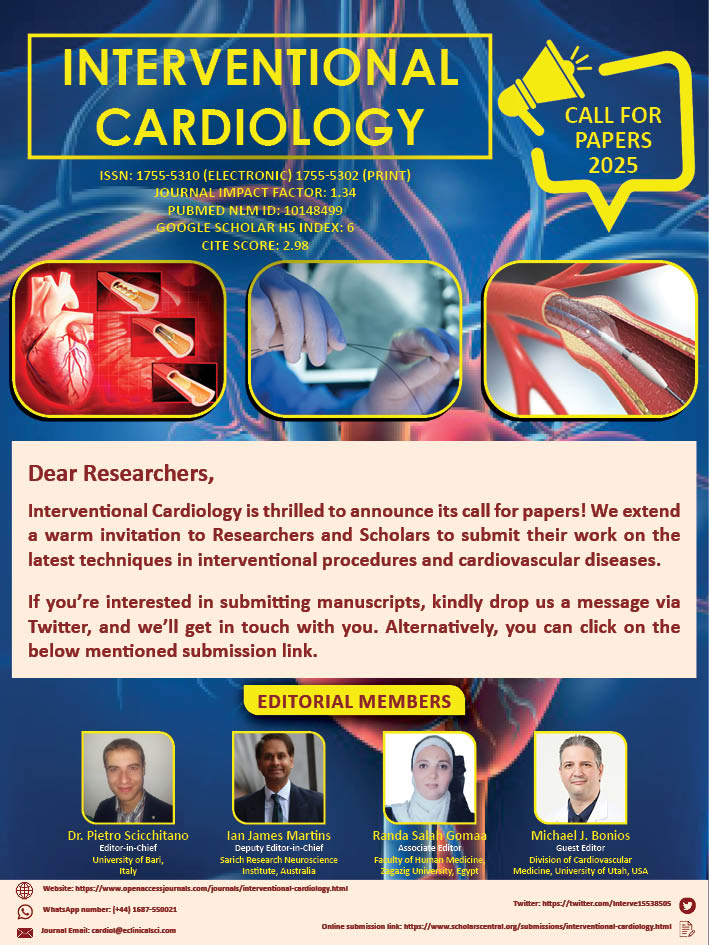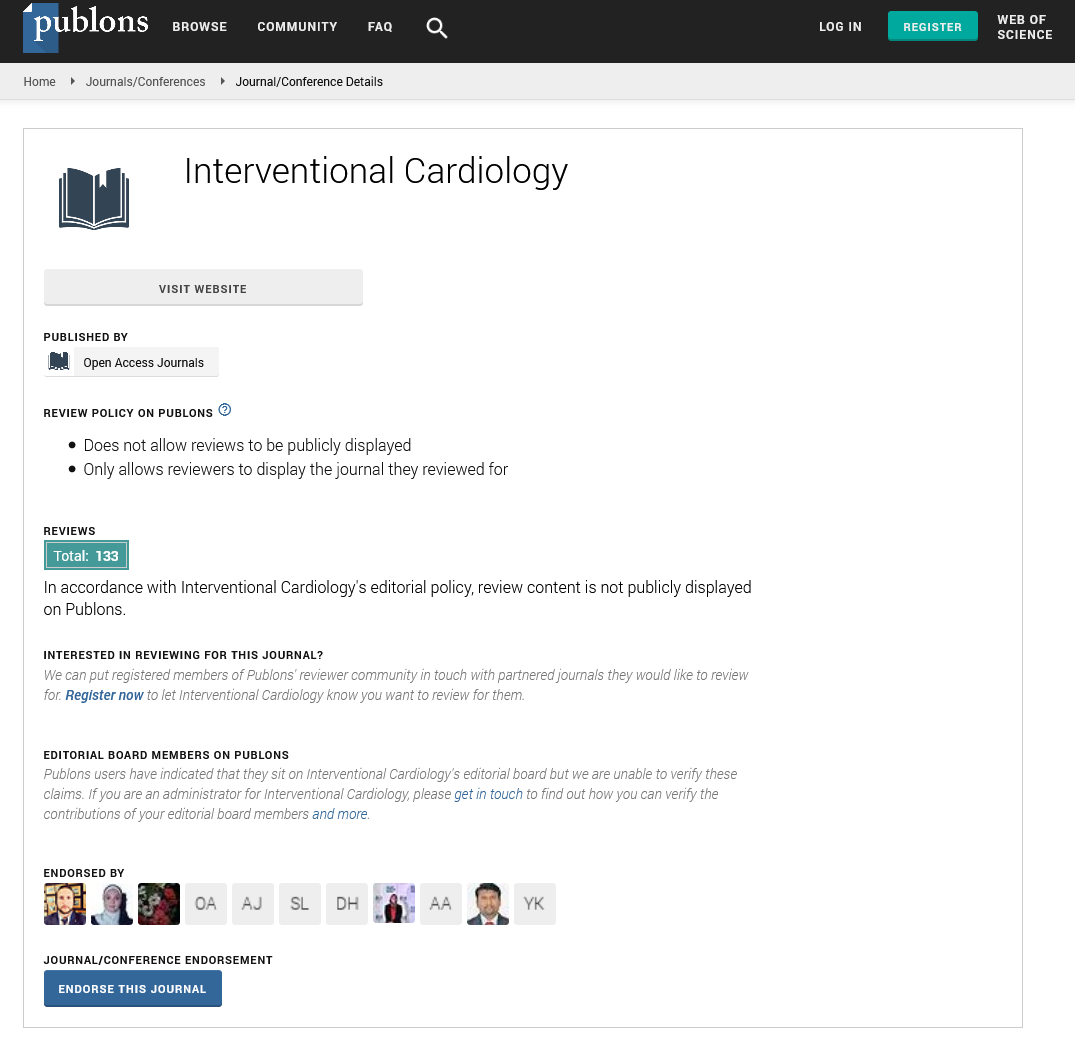Short Communication - Interventional Cardiology (2025) Volume 17, Issue 1
Thrombosis Management in Healthcare
- Corresponding Author:
- Vidhya Meleveetil
Molecular Biophysics Unit, Indian Institute of Science, Bangalore, India
E-mail: vidhyarmenon@gmail.com
Received date: 01-Jan-2025, Manuscript No. FMIC-24-162411; Editor assigned: 03-Jan-2025, PreQC No. FMIC-24-162411 (PQ); Reviewed date: 17-Jan-2025, QC No. FMIC-24-162411; Revised date: 24-Jan-2025, Manuscript No. FMIC-24-162411 (R); Published date: 31-Jan-2025, DOI: 10.37532/1755- 5310.2025.17(1).962
Abstract
T hrombosis condition is a serious aspect in healthcare management. It is involved in conditions arising from pharmacological interventions and Mechanical Circulatory and Respiratory Support (MCRS) devices. The conditions involve blood clot formation, and can be a cause of stroke, myocardial infarction or deep vein thrombosis. P2Y12 receptor is studied extensively in analysing platelet aggregation. Structurally validation confirms the stability of receptor. The intraprotein interaction studies highlight crucial residues essential for ligand binding. Natural ligands have demonstrated comparable interactions with P2Y12, offering potential ligands in place of other drugs which could promote fewer side effects. Thrombosis can be manged through advancements in receptor-targeted therapies, combined with novel ligand discoveries. This would ensure safer and more effective treatment strategies. Continued research in this domain is vital for optimizing anticoagulation therapies and improving long-term patient outcomes.
Description
Balancing the biological system conditions is an important part of healthcare. Many techniques help in obtained the remedial interventions which can include pharmacological advancements, organ transplants, or technology-supported processes. They can also pose challenges, particularly complications such as blood damage and thrombosis which can occur due to stress and interactions with artificial surfaces. Handling thrombosis conditions become essential in such cases. Progress in technologies leading to minimizing blood damage, handling anticoagulation etc., will be essential for success of Mechanical Circulatory And Respiratory Support (MCRS) devices in patient care [1,2] .
Blood clots that form inside the biological system poses danger by hindering the normal functioning of the body. This can lead to many diseases. Thrombosis can also form life-threatening conditions as stroke, myocardial infarction, or deep vein thrombosis [3,4]. Studying receptors in the thrombotic pathway identifies the P2Y12 receptor as a promising target for drug development in thrombosis [5].
While the protein has a stable structure as indicated by RCSB [6], there are many residues in the favored regions and very few outliers, when studied through Ramachandran plot analysis. This is also supported by the protein structure analysis done through Global Model Quality Estimation analysis (GQEA) [7,8]. The intraprotein network of the protein P2Y12 shows high centrality that indicates they have an important role in receptor function. The residues were identified based on high centrality against their connectivity forming central hubs. The drug interactions of the protein P2Y12 with ligands as antithrombotic drugs, give a stable complexes. Natural substitution were explored whose interactions were identified to be comparable with the receptor [9].
Focusing on the protein P2Y12, as a receptor would help develop effective therapeutic strategies targeting thrombosis. The receptor is involved in platelet aggregation. Structural analyses, such as Ramachandran plot validation and Global Model Quality Estimation, confirm its stable conformation, which ensures reliable ligand binding. The intraprotein interaction network highlights specific residues with high centrality, which are essential for receptor function and ligand interactions. Central hub residues can aid in drug development by focusing on key binding sites that influence receptor stability. Additionally, exploring alternative ligands, as natural compounds, offers new solutions for thrombosis regulation. Natural ligands are expected to reducing adverse effects as associated with synthetic drugs. Focusing on both structural insights and new ligand sources, would help therapeutic interventions to have better efficacy in usage in thrombosis [10].
Conclusion
Managing diseases and conditions has become an important part of healthcare, while considering the advancements that are there in pharmacological interventions and while using technological alternatives. However, these have also paved way for complications, including thrombosis due to stress and blood-material interactions. The study of the P2Y12 receptor and its interactions provides further information for improving thrombosis management through targeted therapeutic interventions. A thorough understanding of receptor structure, intraprotein networks, and ligand interactions will enable effective and safer antithrombotic treatments. Research in future should prioritize novel ligand discoveries and refine drug development strategies, ensuring safer and more effective treatments. Improving these approaches will ease thrombosis management and improve long-term patient care.
References
- Simmonds MJ, Watanabe N, McNamee AP, et al. Blood-device interactions. (2025).
- Krabatsch T, Potapov E, Stepanenko A, et al. Biventricular circulatory support with two miniaturized implantable assist devices. Circulation. 124(11_suppl_1):S179-S186 (2011).
- Rosendaal FR. Causes of venous thrombosis. (2009).
- Boon GJ, Van Dam LF, Klok FA, et al. Management and treatment of deep vein thrombosis in special populations. Expert Rev Hematol. 11(9):685-695 (2018).
- Ayyoub S, Orriols R, Oliver E, Ceide OT. Thrombosis models: An overview of common in vivo and in vitro models of thrombosis. Int J Mol Sci. 24(3):2569 (2023).
- Rose PW, Beran B, Bi C, et al. The RCSB Protein Data Bank: Redesigned web site and web services. Nucleic Acids Res. 39(suppl_1):D392-401 (2010).
- Vidhya M. P2Y12 receptor residues crucial for thrombosis regulation. J Mol Recognit. 36(11):e3056 (2023).
- Meleveetil V. Statistical evaluation and characterization of Carica papaya metabolites. Pharmacogn Res. 13(3) (2021).
- Laskowski RA, Furnham N, Thornton JM, et al. The Ramachandran plot and protein structure validation. InBiomolecular forms and functions: A celebration of 50 years of the ramachandran map. (2013).
- Stolzenberg S, Michino M, LeVine MV, et al. Computational approaches to detect allosteric pathways in transmembrane molecular machines. Biochim Biophys Acta. 1858(7):1652-1662 (2016).

